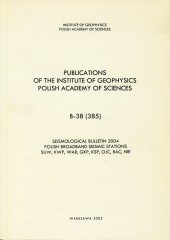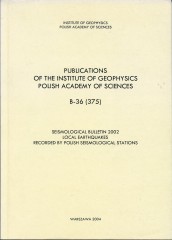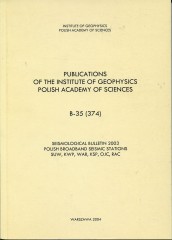BROWSE - VOLUME LIST
- A - Physics of the Earth's Interior
- B - Seismology
-
C - Geomagnetism
C-119, C-118, C-117, C-116, C-115, C-114, C-113, C-112, C-111, C-110, C-109, C-108, C-107, C-106, C-105, C-104, C-103, C-102, C-101, C-100, C-99, C-98, C-97, C-96, C-95, C-94, C-93, C-92, C-91, C-90, C-89, C-88, C-87, C-86, C-85, C-84, C-83, C-82, C-81, C-80, C-79, C-78, C-77, C-76, C-75, C-74, C-73, C-72, C-71, C-70, C-69, C-68, C-67, C-66, C-65, C-64, C-63, C-62, C-61, C-60, C-59, C-58, C-57, C-56, C-55, C-54, C-53, C-52, C-51, C-50, C-49, C-48, C-47, C-46, C-45, C-44, C-43, C-42, C-41, C-40, C-39, C-38, C-37, C-36, C-35, C-33, C-32, C-31, C-30, C-29, C-28, C-27, C-26, C-25, C-24, C-23, C-22, C-21, C-20, C-19, C-18, C-17, C-16, C-15, C-14, C-13, C-12, C-11, C-10, C-9, C-8, C-7, C-6, C-5, C-4, C-3, C-2, C-1
-
D - Physics of the Atmosphere
D-79, D-78, D-77, D-76, D-75, D-74, D-73, D-72, D-71, D-70, D-69, D-68, D-67, D-66, D-65, D-64, D-63, D-62, D-61, D-60, D-59, D-58, D-57, D-56, D-55, D-54, D-53, D-52, D-51, D-50, D-49, D-48, D-47, D-46, D-44, D-45, D-43, D-42, D-41, D-40, D-39, D-38, D-37, D-35, D-34, D-33, D-32, D-31, D-30, D-28, D-27, D-26, D-25, D-24, D-23, D-22, D-21, D-20, D-19, D-18, D-17, D-16, D-15, D-14, D-13, D-12, D-11, D-10, D-9, D-8, D-7, D-6, D-5, D-4, D-3, D-2, D-1
- E - Hydrology
- P - Polar Research
- M - Miscellanea
-
Online First
B - Seismology
Seismological Bulletin 2004. Polish Broadband Seismic Stations SUW, KWP, WAR, GKP, KSP, OJC, RAC, NIE
Author(s): Jankowska W., Kowalski P., Zych A.
Volume: 385
Series: B-38
Volume: 385
Series: B-38
The year 2004 was unique not only because of the occurrence on December 26 of a giant M = 8.8 earthquake near the coast of Sumatra and the following tsunami, causing over 200,000 casualities on the coasts of the Indian Ocean. The year saw also the totally unexpected earthquakes of Kaliningrad Region on September 21, the greatest earthquakes ever noted in Northern Poland and a relatively strong quake in Podhale Region in Southern Poland on November 30, spurting off a long series of aftershocks.
Local Earthquakes Recorded by Polish Seismological Stations 2003
Author(s): Zuchniak M., Niewiadomski J., Guterch B.
Volume: 376
Series: B-37
Volume: 376
Series: B-37
The majority of seismic events recorded in Poland are caused by mining activity in the Upper Silesian Coal Basin and Lubin Copper Basin. Induced seismicity is observed less frequently in the Rybnik Coal District and Bełchatów Open-Pit Mining Area. In 2003, a few local tectonic earthquakes occurred in the Western Carpathians at distances up to about 30 km from station Niedzica.
Seismological Bulletin 2002. Local Earthquakes Recorded by Polish Seismological Stations
Author(s): Draber D., Niewiadomski J., Zuchniak M.
Volume: 375
Series: B-36
Volume: 375
Series: B-36
The majority of seismic events recorded in Poland are caused by mining activity in the Upper Silesian Coal Basin and Lubin Copper Basin. Induced seismicity is observed less frequently in the Rybnik Coal District and Belchatów Open-Pit Mining area. In 2002, a few local tectonic earthquakes occurred in the Western Carparhians at distances up to about 30 km from station Niedzica.
Seismological Bulletin 2003. Polish Broadband Seismic Stations SUW, KWP, WAR, KSP, OJC, RAC
Author(s): Jankowska W., Kowalski P., Wiejacz P.
Volume: 374
Series: B-35
Volume: 374
Series: B-35
This is the eighth yearly report of activity of Polish broadband seismic stations. Since the reinstallation of the STS-2 seismometer at KSP on January 22, during 2003 the stations worked normally, except for occasional problems that are listed in section 3.
Application of Monte Carlo Techniques for Solving Selected Seismological Inverse Problems
Author(s): Dębski W.
Volume: 367
Series: B-34
Volume: 367
Series: B-34
This book is not intended to be an essay on the general inverse theory but rather a discussion of a particular technique used in the framework of the probabilistic inverse theory, including some new axiomatic elements of the theory, with advanced applications based on the Monte Carlo technique. For this reason, to present inverse problems and the techniques used to solve them, I chose the pragmatic, phenomenological approach which underlies the meaning of the various elements of inverse problems at the cost of mathematical rigors.






